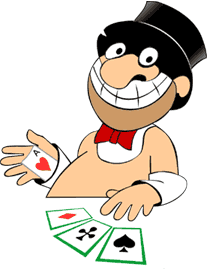
Although, today the term "Baccarat" is usually referred to the American Baccarat played in North America, there are many other variations of the game which you can find in other countries. They come under different names and rules, but the object of the game is the same - to get winning hand as close to 9 as possible.
The elements that distinguish these games from one another are:
- Who is permitted to play the role of the bank
- Drawing rules
- Some other differences.
You can find this variation of baccarat game in some European casinos (mostly French casinos). It is not played in the North America where casinos prefer to cultivate Nevada Baccarat, described on American baccarat page.
The object of the game is the same - to get winning hand as close to 9 as possible, and the hand values determined by the same rules as for American baccarat.
The main difference is that the casino doesn't play the role of banker, In Chemin de fer you cannot just bet on Player or Bank (Punto or Banco), you must be one or the other. The players wager among themselves, and the bank rotates among the players. The play of the banker can be declined, it then passes to the next player to the right, so the shoe moves counterclockwise around the table like a train (Chemin de Fer is French for "railroad").
In American baccarat you are playing against the House and the casino provides the financial backing for the game. In Chemin de Fer the Casino has no direct involvement in the betting. It only provides:
- A dealer or "Croupier" to make sure the rules are adhered to and that everything runs smoothly.
- The necessary gaming equipment; table, chairs, the shoe called "sabot" and the cards.
For all these, the Casino takes a percentage commission, or rake, (usually 5%) on all winning Bank hands.
Another difference is that that unlike the American Baccarat, Chemin De Fer has flexible drawing rules for the third card:
- Player has the option of either drawing or standing on five (In the Nevada baccarat the player automatically hits if he has total of 5 or less).
- The play of the banker is completely optional.
European Baccarat has two key differences in rules as compared to American Baccarat:
- The player has the option of standing or drawing on 5.
- The banker (controlled by dealer) also has an option on whether to draw a third card, although in practice the casino generally follows the rules of play for American baccarat.
The casino finances the banker hand. Example: The Banker funds $1,500. If a player bets $1,000 and the second player bets $500, the next players are not allowed to bet now any more.
When a player wants to cover the entire banker's bet, he calls out "banco" and no other players are allowed to bet during that round.
Players who choose to bet with the bank to win are charged the same 4 or 5 percent of their winnings, like in any other version of baccarat.
Baccarat en banque
This variation of Baccarat you can find in some European casinos. The goal of the game is the same - to get as close to 9 as possible, but the difference is that only the house plays the role of banker (the bank is operated by a casino employee).
In other versions of the game (Classic or Chemin de Fer) the player with the most money is usually declared the banker or the deal rotates among the players by passing the shoe counterclockwise around the table, and each "Player" alternate being the "Banker".
Since the Casino is a Banker, the bets can be much larger than when another player is acting as the bank. Also, the game can be played with as few as one player (in Chemin de Fer there must be two players at least to players to start the game).
Other rules:
- Three hands are dealt: One bank hand and two player hands.
- The players are allowed to bet on one or both of the player hands, but never on the dealer's hand.
- There are no particular drawing rules, it's completely optional. Sometimes, the dealer will follow the American baccarat rules, other times he will alter them to enhance his winning chances.
Other differences
- Some casinos may charge a lower commission than 5%
- The payouts on the Tie bet may vary from casino to casino - sometimes it's paid 9:1.
- In European casinos they usually use chips to place wagers, while in North America real money are used for betting that makes the game more exciting.